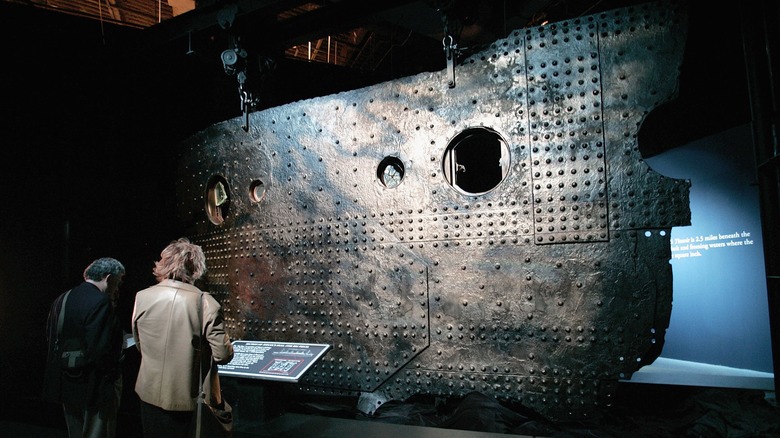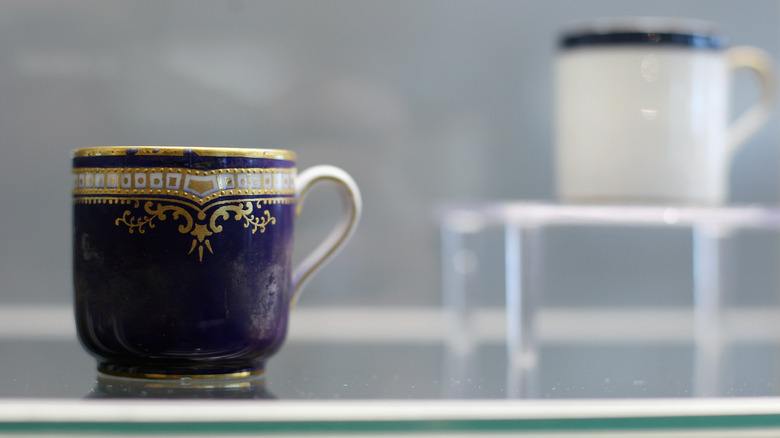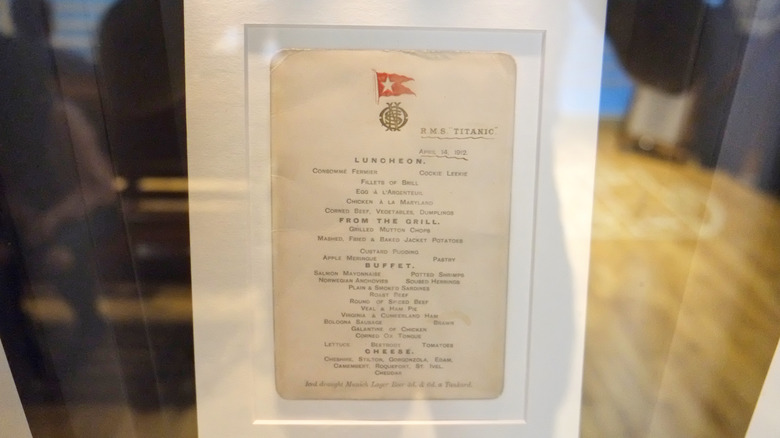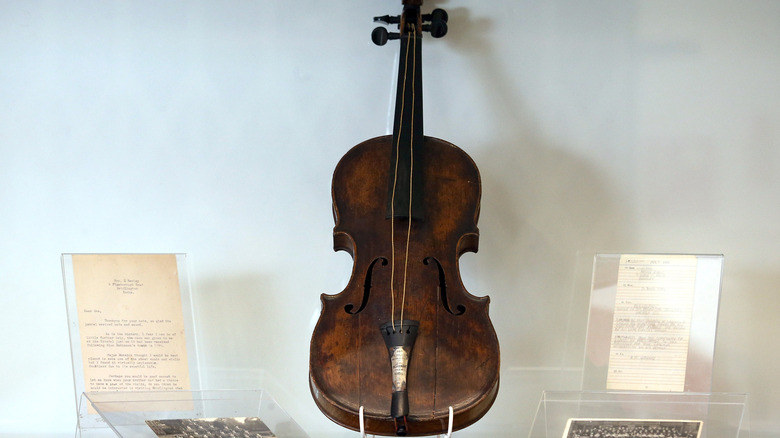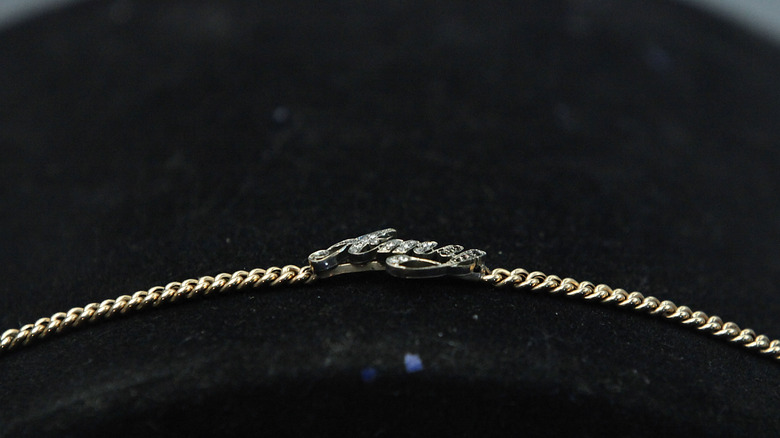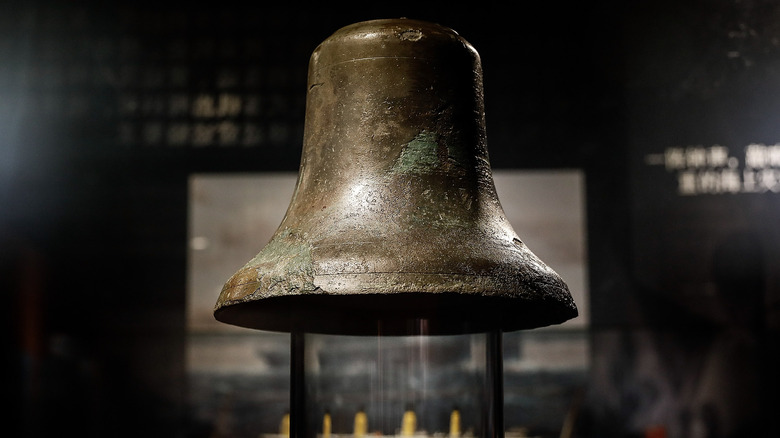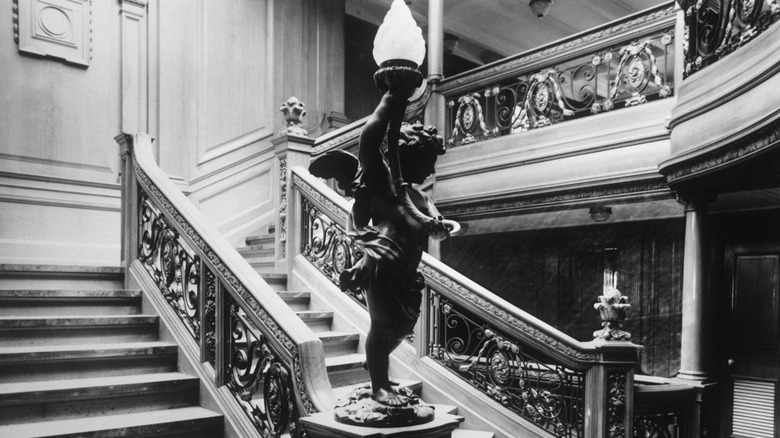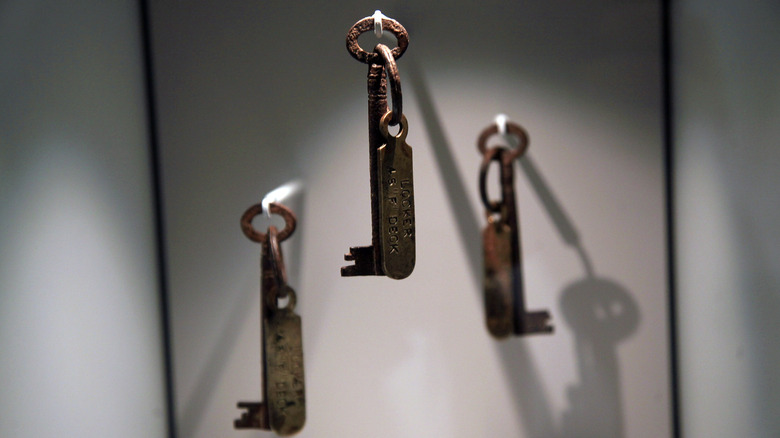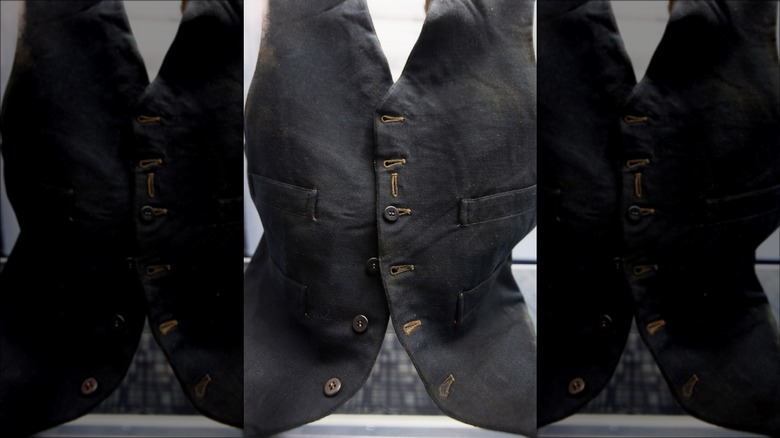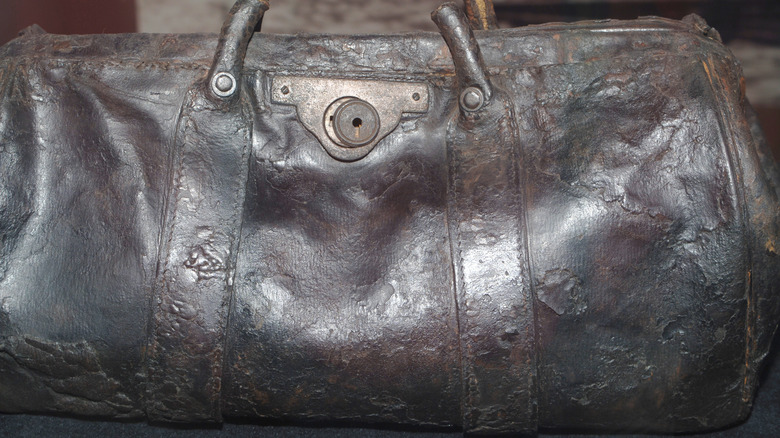13 Artifacts Recovered From The Titanic Wreck
Why has the Titanic generated so much interest over the years? It could be because the wreck of the massive ocean liner, late on April 14, 1912, led to a stupendous loss of life. Though there's debate about the exact number, over 1,500 people died after the Titanic struck an iceberg and sank. The ship split into two pieces that fell some 12,500 feet and scattered debris across the sea floor.
Deep sea explorer Robert Ballard first discovered the wreckage of the Titanic in 1985, opening up a new focus on the Titanic that included not only a 1997 blockbuster movie but efforts to pull up bits of the wreck and put it on display.
Fascinating as these artifacts are, they also come from a tragedy. Bringing up objects from the Titanic can garner accusations of grave robbing and has sometimes left salvagers in an uncomfortable position. Paul Henri-Nargeolet, a Titanic expert who died aboard Oceangate's Titanic submersible on June 18, 2023, often found himself in such a position. Speaking to Forbes in 2012, Nargeolet admitted that some survivors had told him they were unhappy about salvage work, while others were supportive. "My belief is that it is good to record the artifacts, that it's good for education and preservation," he said. Whether or not you agree with his assessment, it's hard to deny the intense interest some of these objects recovered from the Titanic can still generate.
A 15-ton section of the ship
Though some people have suggested recovering most or even all of the Titanic wreck, it's safe to say they have more dreams in their heads than pure logic. Besides being, you know, the remnants of a giant ocean liner that lie about 12,500 feet below the surface, the Titanic is pretty fragile. The metal of the ship itself is being eaten away by deep-sea bacteria that leave behind crumbling rusticles, making the idea of raising the whole ship little more than a wild fantasy.
That doesn't mean parts of the ship haven't made it to the surface. In 1998, salvage company RMS Titanic, Inc. pulled up a 15-ton section of the wreck. A previous attempt two years earlier had failed when a cable reportedly snapped mid-recovery.
When salvagers brought the hull section to the surface in 1998, they found that it was covered with debris and sea life. RMS Titanic, Inc. which was granted sole rights to draw artifacts from the wreck site in 1994, was also forbidden from selling those artifacts and had to take on the responsibility of stabilizing them. To that end, the Big Piece, as it became known, was cleaned of corrosive salts and covered with a protective coating before it went on exhibit in Las Vegas. Today, it's still on display in Titanic: The Artifact Exhibition at the Luxor Hotel & Casino.
China plates and cups
Dinner plates and teacups may seem pretty humdrum, but when they point to the history of a tragic ship and the many people who were aboard on its last voyage, they're worth a second look. Certainly, the first-class plates recovered from the wreckage of the Titanic are beautiful in their own right. Made from fine china and decorated with gold and pricey blue cobalt, it's easy to imagine a fancy lady dining off of these next to her robber baron industrialist husband.
Second-class passengers aboard the Titanic could perhaps convince themselves that they were doing all right in the world. However, the second-class plates brought up from the wreck are far less fancy once cleaned of the deepwater muck. The second-class china's blue floral pattern is nice, to be sure, but doesn't quite compare to the delicate beauty of the first-class set.
At least the third-class and crew members were unlikely to have any illusions about their place in the Titanic hierarchy. They, too, ate off dedicated plates, but these were far removed in style from the fine, hand-painted dinnerware of first-class passengers. Instead, plates salvaged from the Titanic reveal that third-class passengers and crew used simple white sets that were stamped with the red logo of the White Star Line.
The ship's last menu
First-class passengers wouldn't have known it at the time, but even the menu describing their meal on April 14, 1912, would end up as a pricey historic artifact. That's in part because it was the last meal served to the highest-paying passengers on the ocean liner. This particular menu found its way into the purse of Ruth Dodge, the wife of California banker Dr. Washington Dodge. Dr. Dodge had been receiving medical treatment in France and his small family was returning to America aboard the Titanic. Ruth, Washington, and their four-year-old son, Washington Dodge Jr., survived the sinking of the liner.
The Dodges would have been able to pick from a vast array of foods for their luncheon. These included rather fussy Edwardian options like eggs Argenteuil, which came with delicate asparagus tips, and a rather mysterious (for first-class, anyway) bologna sausage. Hopefully, someone was living it up with the extensive selection of cheese and a nice tankard of Munich lager, as it would have been their last chance to indulge before the fateful accident.
A violin
One of the most iconic facets of the Titanic legend is the ship's band staying behind, playing tunes like the hymn "Nearer, my God, to thee" to keep everyone calm. Titanic survivors confirmed that the band played nearly to the end, though some maintain that they were playing a more cheerful waltz or newfangled ragtime to keep spirits up.
But it may be that the story of what happened to Wallace Hartley's violin is even more compelling. It was given to Hartley by his fiancée, Maria Robinson, who watched her husband-to-be set off for a gig on the Titanic ahead of their June 1914 wedding. Hartley died in the shipwreck, but his body was recovered. An inventory of the effects found with him doesn't include the violin, though Robinson later wrote that she was grateful to have also received her fiancé's violin. After Robinson died in 1939, it went through a series of owners until it was found in an attic in 2004.
Testing confirmed that it was indeed Hartley's violin, including evidence of time spent in seawater that left salt deposits and two significant cracks in the body of the instrument. On October 19, 2013, it was auctioned for £900,000 to a private owner. Adjusted for inflation to 2023 values, the violin sold for the equivalent of more than $1.2 million.
A bejeweled bracelet
In 1987, salvagers brought up a bracelet that may have seemed oddly modern to some eyes. Sporting the name "Amy," this rose gold, silver, and diamond bracelet looks an awful lot like more modern name jewelry sported by someone walking down the street. However, the seabed provenance of this artifact makes it all too clear that it went down with the Titanic. It was found in a leather bag that protected it from the seawater. Also, due to the tanning process, the bag was unpalatable to the oceangoing microorganisms that quickly disassembled other pieces of Titanic debris, further shielding its contents.
But who was Amy? It wasn't a very common name at the time, at least amongst Titanic passengers. Records indicate that there were only two women by that name on the liner's voyage, though it may also have been a nickname for another woman with a similar name. In "Titanic: Women and Children First," author Judith Gellar theorizes that the bracelet's owner may have been Amy Stanley, a third-class passenger who survived the sinking. However, it would be an oddly fine bit of jewelry for someone with a low-cost ticket and Stanley isn't known to have mentioned a lost diamond bracelet. Currently, no one has been able to definitively identify the mysterious bracelet-bearing Amy.
Perfume samples
As salvagers will readily tell you, the environment in which the Titanic currently lies is not a comfortable one, with strong deep water currents and microbes that consume metal and leave behind fragile rusticles. So, it's remarkable that delicate glass perfume vials survived the intense trip from the ocean's surface to the sea floor, and back up again.
In the summer of 2000, a salvage crew recovered a small leather pouch from the wreck. Salvage expert Dik Barton told ABC News that it wasn't clear what was inside until they brought the bag into a shipboard laboratory, where they smelled floral perfume. Ultimately, they found three bags containing perfume samples left behind on the Titanic.
The satchels were labeled with the name of Adolphe Saalfeld, a German Jewish man who was in business as a perfumer. Saalfeld was aboard the Titanic as a first-class ticket holder, carrying 65 vials of sample scents that he likely intended to use to gain American clients for his Saalfeld & Co. business. But, after the ship crashed into an iceberg and began sinking into the frigid waters of the North Atlantic, Saalfeld likely wasn't all too focused on his fragrance business. Though he survived the sinking, he left the vials behind, and they went down with the ship. They had a second life, however, as the surviving scents formed the basis for the Titanic Legacy 1912 fragrance sold in a very modern way: on the QVC television shopping network.
One badly damaged letter
In 2017, a waterlogged letter sold for £126,000, or the equivalent of $160,000 today. Of course, this was no ordinary bit of mail. Not only had the letter in question come from the Titanic, but, remarkably, someone had managed to fish the still legible missive from the ocean and, eventually, deliver it to its recipient.
The actual content of the letter, dated just a day before the disaster, isn't especially interesting. The writer, Alexander Oskar Holverson, was a businessman traveling home to New York with his wife, Mary. Writing to his mother, Holverson couldn't help but comment on the grand size of the ship. He also noted that the ridiculously rich John Jacob Astor IV even deigned to sit on the deck just like normal folk — at least, the ones who could spring for a first-class ticket.
Astor and Holverson both died in the disaster, while both of their respective wives survived. At least both men's bodies were found, and Holverson's letter was recovered from a pocketbook on his body. Even though it lacked postage and was damaged by seawater, it was still delivered to his mother.
A deck bell
Though it may not be the most glamorous item recovered from the Titanic wreck, one of the doomed ship's deck bells still carries plenty of historic weight. This seemingly humble bronze bell, salvaged by RMS Titanic, Inc., was part of the lookout location on the forward part of the ocean liner. This is where Lookout Frederick Fleet would have first spotted the iceberg that would so critically damage the Titanic. His response was to ring this bell three times in an attempt to alert the bridge crew of the looming danger, though calm waters and a dark, moonless night meant that Fleet didn't spot the berg until it was dangerously close.
The bell ringing and Fleet's proclamation of "Iceberg, right ahead!" while speaking to the bridge didn't do much to avert disaster. At least Fleet himself managed to survive the Titanic's sinking and lived until 1965. His bell, however, went down with the ship for the next seven decades until it was recovered in the late 1980s.
A decorative staircase cherub
No story of the Titanic is complete without at least a glance at its iconic Grand Staircase. It's an eye-catching set in director James Cameron's 1997 mega-hit film, "Titanic," allowing viewers to gawk at ocean water rushing down its steps during the disastrous height of the story. A recreation of the Grand Staircase also features prominently in the Titanic: The Artifact Exhibition installation in Las Vegas.
Too bad we don't know what the Titanic's Grand Staircase actually looked like. Photos that purport to show it are actually of the staircase from the Titanic's sister ship, the Olympic. Given the design similarities between the two vessels, it's probably close enough; it certainly was for Cameron, who used the Olympic photos for his movie's set design. Yet, given that the Grand Staircase was apparently damaged during the sinking or collapsed into ruin at the shipwreck site, we can't say for certain that Cameron and his team got it right.
At least there are pieces of the Grand Staircase that may have survived. RMS Titanic, Inc. recovered a bronze cherub statue that would have adorned one of the first-class staircases, though some researchers suggest that this particular figure could have come from another, smaller staircase. We do know that the Grand Staircase also sported cherub statues. This one may bear the marks of the ship's intense descent into the depths, as its missing left foot may have popped off when the statue was wrenched from its post.
An alligator-skin purse
As a milliner, Marion Meanwell must have understood fashion. Sure, she was a third-class passenger on the Titanic, but making hats was her business. She may have hoped that she could continue that work in the United States, given the stylish alligator-skin bag she was carrying included an endorsement noting that Meanwell always paid her rent on time. Presumably, she meant to present it to a new landlord to make her tenant application a little shinier — and perhaps also to make immigration officials look more kindly on her entry into the country.
Unfortunately, Mrs. Meanwell's hopes met a tragic end, as she did not survive the sinking of the Titanic. However, many decades later, salvagers were able to pull her still-intact alligator purse out of the debris field surrounding the wreck. When they opened it, they discovered not only the landlord's endorsement but also key documents such as her marriage license. Conservator David Galusha told The New York Times that these seemingly perishable documents survived in part because the damaged ship and its contents settled in the deep, dark ocean, far away from light or much oxygen. Meanwell's high-quality bag, made out of a relatively thick hide, also worked to preserve its contents.
One locker key
One small key may seem inconsequential, but to some who were aboard the Titanic, it may point to their survival or their death the night of the ship's sinking. Recovered from the wreck site shortly after the liner went down, this unassuming key carries a tag reading "Locker 14 F Deck." It was found on the remains of Sidney Sedunary, a young third-class steward, and indicates that Sedunary would have been on the F Deck at some point on the fateful night of the Titanic disaster, though it eventually flooded. Auctioneer Andrew Aldridge even went so far as to call Sedunary a hero, telling the BBC that "without a doubt [he saved lives]. Here's a man who sacrificed his life to save others."
Though there's no eyewitness testimony to any particular acts of heroism on Sedunary's part, there is no denying that this small locker key is a part of history. Buyers with some seriously deep pockets certainly thought so. In 2016, the key alone sold for a staggering £85,000. Adjusted for inflation, that comes out to about £110,880 in 2023, or about $140,889.
Part of one man's ensemble
The rather tough luggage of the early 20th century proved to be useful to salvagers and historians who were investigating the wreck of the Titanic, despite the passage of a few decades. Though there's scant evidence that sturdy suitcases or well-traveled valises did much to help people in a practical sense on the night of the sinking, these everyday objects have done much to preserve the history of the Titanic and the people who booked passage on it. Take the suitcase of William Henry Allen, which helped to preserve quite a few of his personal effects even though Allen, a toolmaker, died in the sinking.
Collections director Alex Klingelhofer, who helped produce the Las Vegas-based Titanic: The Artifact Exhibition, told the Las Vegas Review-Journal that Allen was quite stylish, sporting a polka-dot scarf and leather dress boots. His suitcase also preserved about 150 documents, though the leather container had been submerged for many years.
Inside the suitcase, salvagers also found a wool vest owned by Allen, still sporting its buttons despite going through about two and a half miles of icy ocean water to the bottom.
A bag full of jewels
Even if researchers are genuinely thrilled when they find a well-preserved purse or learn about a waterlogged letter that made it off the Titanic, surely they would also be pretty darn excited to find something shiny. There were plenty of well-off passengers who were traveling first-class, after all. And while some of their wealth was assuredly tied up in stocks and real estate, it's clear that they weren't above dropping ridiculous amounts of money on bling, too.
That much was clear to salvagers who, in 1987, pulled up a leather bag full of jewelry from the wreck site. The night of the sinking, the bag was almost certainly one of many such containers that were under the protection of the ship's pursers, crewmembers who were in charge of handling money and safekeeping passengers' valuables. Pursers worked to place the bags on lifeboats, but the 1987 discovery made it obvious that not all made it to shore in 1912.
A century later, the jewels in this particular bag were part of a glittering exhibit of Titanic valuables. They include a unique necklace made with gold nuggets. No one's sure who it belonged to, but speculation has landed on Margaret Brown, otherwise known as the "Unsinkable Molly Brown." Besides being the child of working-class immigrants who made it as a socialite and philanthropist, she was the wife of mining magnate J.J. Brown, who could have given her the necklace.

